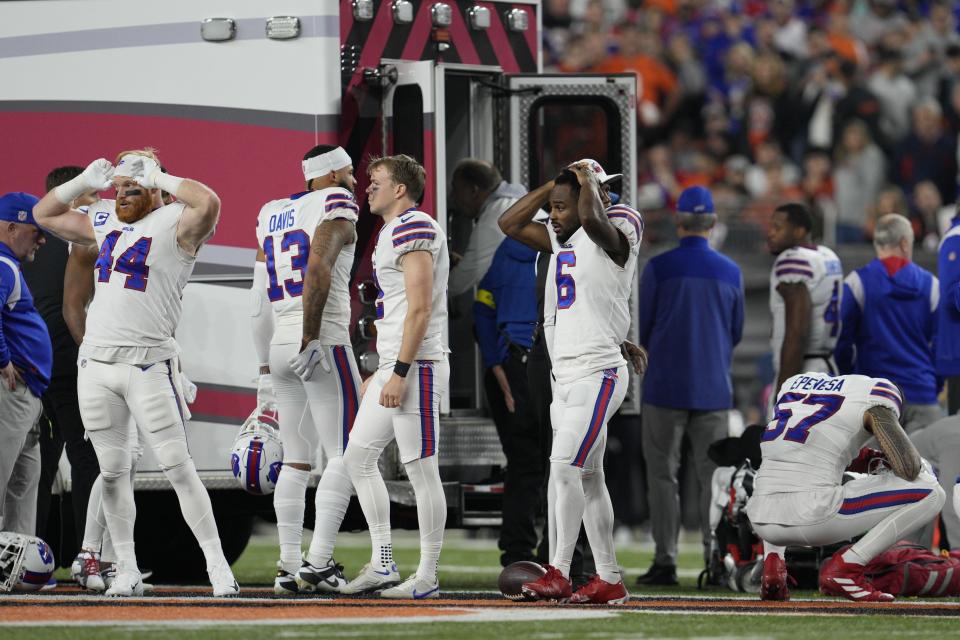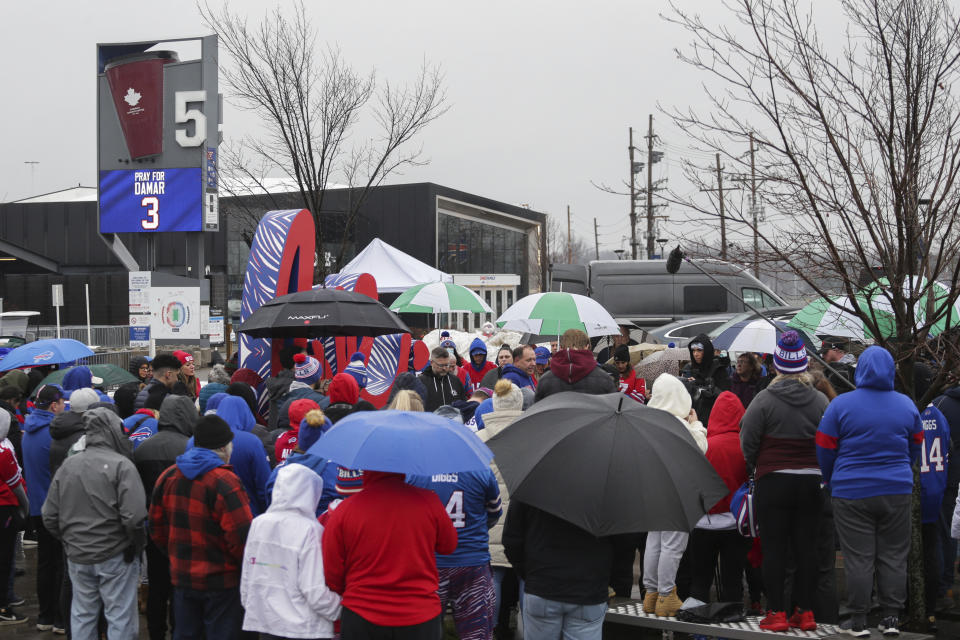What happens now?
It’s a question being grappled with in so many corners of the NFL and beyond on Tuesday, as a young man lies in a Cincinnati hospital room in critical condition, his future uncertain. His future life, we mean, not his future as a football player.
For so long, the NFL’s overlords have behaved as if nothing could stop the league, certainly not stop its profits. The oligarchs who have weathered all manner of should-be embarrassing headlines in recent years, from multiple team owner sex scandals to nuclear-waste levels of toxicity in workplace environments to continued abject racism in the form of race-norming and ignoring highly qualified Black coaching candidates. More and more it seems the approach to tamping the resulting outrage isn’t to finesse the optics but to shrug, ignore and get to the next game day.
On Monday night, though, Buffalo Bills safety Damar Hamlin made a tackle against the Cincinnati Bengals, stood up, and then immediately fell back to the turf in Cincinnati. His heart stopped, and medical personnel administered CPR for several minutes to restart it. Teammates were in tears, their young faces showing their shock at the situation.
They all know playing football comes with essentially a 100% injury rate. They never consider death, and there it was on the field with them.
As retired NFL defensive back and current ESPN analyst Ryan Clark said Monday night, “At the age of 24, I didn’t even know I could die.”
So what happens now?
Particularly as they’ve been able to share their thoughts directly via social media, athletes have repeated one thing perhaps more than any other: they are humans first. For all of their success and skill and for some, significant paychecks, they can’t outrun or outmuscle everyday life.


The way so many view professional athletes as interchangeable and disposable seems especially acute when it comes to NFL players, for a variety of reasons. They wear pads and helmets on the field, so only those most accomplished or most coveted by marketing companies become instantly recognizable when those are stripped away.
Unlike the NHL, where there are only six players per side on the ice at any time, and the NBA, which has five and caps rosters at 15 players, there are 22 players on the field for every snap in the NFL. And teams have dozens of men on the roster between active status, practice squad and injured reserve, making it even harder to get attached to individuals.
The NFL’s power holders contribute to the feeling. When a player is hurt, whether for two weeks or an entire season, coaches will flatly say it’s “next man up,” and for many organizations, the injured player is hidden from the public, not spoken of by the head coach or to by reporters until he’s healthy enough to rejoin the machine and contribute.
Team owners refuse to guarantee contracts, not acknowledging the very real risk players assume, that their first NFL game could be their last and making it so a coach who wants to “send a message” to a team on a losing streak can cut loose a lesser-used player because he apparently believes that will make those who remain work harder toward a win.
Team- and league-friendly media have been all too happy to uphold these narratives over the years, reinforcing the idea that these players, particularly non-quarterbacks, are a dime a dozen. For too many it has all been transactional, with any sense of humanity lacking.
And fans have followed suit. Especially as fantasy football has skyrocketed in popularity, too many don’t see human beings, only points on an app. If a player leaves AnonymousFanBunchanumbers’s favorite team to sign with a division rival, he can expect angry tweets calling him a traitor. If a player underperforms and a fantasy player loses his playoff matchup and a few hundred bucks because of it, he may get threatening or profanity- and racism-filled direct messages, as if the player doesn’t feel terrible enough that he let his team down or affected his own job security, and his only intention was to screw some rando in Spokane.
We’ve seen incremental changes in some of these things in more recent years, as players have awakened to the reality of how much power they have (they still don’t exercise it nearly enough, but that’s a discussion for another day). And a new generation of coaches understand that a happy, healthy — physically and mentally — player is a better player.
Writing that the shock of what happened to Hamlin on Monday night is a reminder that players are human seems trite. We’ve seen devastating injuries on football fields before; heck, earlier this season, on the same field, the NFL-viewing world was reminded what a “fencing response” is after Miami’s Tua Tagovailoa was concussed and his arms and hands curled toward his face.


After a few minutes of Tagovailoa laying on the ground, he was taken off by medical staff and the game resumed, the show going on because the NFL demands that it does.
It is so routine for players that even on Monday night, some of them reflexively began to warm up again after an extended stop following Hamlin’s injury. All this while the horror, uncertainty and the feeling about what happened to Hamlin was different than anything any of them had experienced before and hanging thick in the air. They’d all been at practice or at a game before, watched a teammate or opponent suffer a potentially career-ending or life-altering injury, then heard a coach’s whistle, moved the huddles a few yards and kept going.
It should not be normal. Not in the NFL, not anywhere. There’s so much that needs fixing with the league that has needed to be fixed for years, but the prevailing callousness is one place to start.
On Monday night, the NFL stopped. Even non-sports networks turned their focus to Hamlin’s health, the heartbreaking images of his despondent teammates, and the reality of a league that has always just moved on being forced to put things on pause.
People from all over the country, desperate to show support for a player many hadn’t heard of before one horrifying moment, donated to Hamlin’s foundation, through which he’s held toy drives for kids in his hometown. As of Tuesday afternoon, over $4.5 million had been given in roughly 18 hours.
It should not take a young and seemingly healthy player having an on-field heart stoppage for anyone to realize that under the helmets and pads are human beings, eschewing team loyalty to pray for an opponent.
What happens now, at minimum, is that feeling remains with league executives, team executives, coaches, media and fans, far beyond Monday night, long after the games begin again. None of it has ever been normal, but after Monday, it never should be treated as though it is again.
